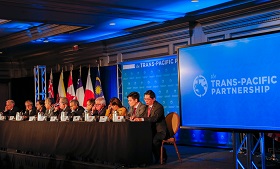The APEC Economic Leaders’ Declaration signed on November 18, 2015 highlighted the shift of the Forum’s focus towards domestic economic development and qualitative growth, putting an end to the five-year period of geopolitical and economic heavyweights. Between 2010 and 2014, APEC was chaired successively by Japan, the United States, Russia, Indonesia and China – all major global players whose ambitions reach far beyond the region’s boundaries. These countries, being members of G20, were able to link the work of APEC with issues on the global economic agenda.
The APEC Economic Leaders’ Declaration signed on November 18, 2015 highlighted the shift of the Forum’s focus towards domestic economic development and qualitative growth, putting an end to the five-year period of geopolitical and economic heavyweights. Between 2010 and 2014, APEC was chaired successively by Japan, the United States, Russia, Indonesia and China – all major global players whose ambitions reach far beyond the region’s boundaries. These countries, being members of G20, were able to link the work of APEC with issues on the global economic agenda.
In 2015, APEC chairmanship passed to the Philippines, one of the region’s developing economies. Its priorities are largely domestic: the fight against poverty and inequality; food shortage; the low level of education; and an underdeveloped infrastructure crippled not only by the shortage of investment, but also by exposure to natural disasters. Thus, “inclusiveness” and “resilience” were the key concepts of APEC 2015, with most of the discussions and events devoted to structural reform and the development of micro-, small and medium-sized business, human capital and food security, and combating emergencies and natural disasters.
Within APEC, the problems of development and quality economic growth were first raised by Japan in 2010. Five Growth Attributeswere proposed within the framework of the APEC Leaders’ Growth Strategy – Balanced, Inclusive, Sustainable, Innovative, and Secure Growth. In 2015, the economies attempted to report the achievements of the previous five years, but it proved a bit of a challenge, as the Japanese initiative did not propose any quantative indicators as a basis for comparison. Such indicators (Key Accountability Areas) were proposed in 2015 and spelled out in a supplement to the leaders’ declaration.
For Russia, promotion of economic growth and sustainable development are far more relevant and interesting themes than the APEC integration agenda, to which Russia has little to contribute, and about which it can hardly boast. The APEC partners gave a cool reception to the Eurasian Economic Union created in 2015 in the Asia-Pacific context. Even the agreement on a Free Trade Zone with Vietnam signed in May 2015 and the project to link the Eurasian Economic Union with the Chinese Silk Road economic belt initiative did not afford mentioning of the Eurasian Economic Union among APEC’s regional integration achievements of 2015 in the Leaders’ Declaration (link in Russian). At the same time, such a pointed refusal to acknowledge the Eurasian Economic Union may be another sign of the increasingly politicized modern integration agenda. One thing that can safely be said is that the pivot towards socioeconomic and humanitarian issues within APEC may be to Russia’s advantage if Russia joins the effort in a timely and effective manner. It is in this area that Russia has something to share with, and even be of assistance to, the developing world. Russian answers to the issues of development are often far more people-centered, efficient and relevant to the real needs of the developing countries than the highly mercantile recipes of APEC’s Western participants.
Russia’s potential in addressing the problems of food security in the APEC region is particularly noteworthy. Unlike the developed APEC economies, which see food security primarily in terms of the sustainability of food markets, setting common standards and regulations for promoting their business interests, Russia is prepared to respond to the urgent needs of the developing economies which regard food security in terms of investment, technologies, agricultural innovations, improving transport and logistical chains, providing the population with quality products and reducing post-harvest losses. The creation of the Russian Information-Analytical APEC Center for Agricultural Biotechnology in 2015 deserves special mentioning.
Russia has established solid authority within APEC in matters of humanitarian emergency response. Plans are in motion to integrate the National Crisis Management Centres (NCMCs) into a single international regional network to ensure rapid exchange of information and effective coordination in the event of major disasters in the region. The idea has been widely approved among APEC economies.
Russia’s traditional activity in human resource development was particularly relevant in 2015, when APEC discussed the relevance of professional competences to economic needs, flexible professional training and retraining systems, and the possibilities of creating a common APEC framework of professional qualifications that could give a boost to quality labour mobility in the region. The Philippines was particularly interested in Russia’s experience in the field of science and technology in education that turned to be a topic of a separate high-level meeting.
Thus, in 2015, socioeconomic problems overshadowed the issues of regional integration. For the first time in APEC history, regional integration was at the very bottom of the Leaders’ Declaration. In addition to the above-mentioned domestic political priorities of the Phillipines hosts, such pointed downgrading of the key APEC issue can be attributed to the fact that it became very politicized in 2015that is unacceptabe for APEC. This is primarily due to the confrontation between two major economic players, the United States and China, and the two corresponding “mega blocs” – the Trans-Pacific Partnership (TPP) and the Regional Comprehensive Economic Partnership (RCEP). The Trans-Pacific Partnership, finalisation of negotiations of which was announced shortly before the APEC Leaders’ Meeting and which was incubated within APEC, had every chance to steal the APEC Leaders’ week headlines. But it all boiled down to a brief meeting of 12 TPP leaders outside the summit’s main programme and an emotionless reference to the agreement in the declaration as one of possible Pathways to the Free Trade Area of the Asia-Pacific (FTAAP), along with the need of the early completion of negotiations for Regional Comprehensive Economic Partnership (RCEP). , of which the Philippines is a member.
Why did the Philippines prevent the United States from celebrating its triumph in Manila in a big way? We can assume at least two reasons. First of all, technically the Philippine leaders were not thrilled by the prospect of having celebrations in their country without their own participation (the Philippines is not a TPP member), though the issue could well have been settled considering that the Philippines and the United States have been allies for many years. Far more important is the fact that special attention to the American project could have annoyed China, with which the Philippines has enough problems as it is, especially in recent years due to the escalation of the situation in the South China Sea. It was unclear until the very last minute whether the Chinese leader would come to Manila at all, and perhaps he only agreed on condition that the hosts would not play up the successful U.S. integration project. To avoid antagonizing China, special attention was paid to discussing the prospects of creating the Free Trade Area of the Asia-Pacific (FTAAP), one of the key initiatives of the Chinese chairmanship of APEC in 2014. This is what led to the launch in 2015 of the Collective Strategic Study on Issues Related to the Realization of the FTAAP. Unlike the very concrete TPP and RCEP projects, the FTAAP is particularly appealing for Russia because so far it does not impose any specific obligations. The current stage includes information exchange, which Russia has readily made available, as it has experience of integration activities at the Eurasian Economic Union.
In addition, the discussion of trade liberalization at the summit revealed a marked trend of multilateral approaches to world trade regulation gradually being replaced by regional integration initiatives. Obviously, the ongoing crisis within the World Trade Organization doubled with announcement of the TPP Agreement, which is unprecedented in its coverage, has undermined the faith of many APEC members in the viability of the WTO as a multilateral trade system. The WTO crisis of confidence was evident during the discussion of a separate statement on supporting the multilateral trading system – a document traditionally issued by all APEC summits – confirming the strong link between APEC and the WTO on trade liberalization issues. In 2015, Russia’s position in consistently supporting the key role of the WTO occasionally contrasted sharply with the lukewarm attitude displayed by other participants. It has to be admitted that, right now, Russia has no option but to continue upholding multilateralism in world trade because of all the APEC members only Russia, Taiwan, Hong Kong and Papua New Guinea do not participate in any regional integration group in the Asia-Pacific.
Interestingly, the Philippines managed to combine the domestic socioeconomic and the trade liberalization agendas by bringing up the topic of the services sector. It all started in winter 2015 with the discussion of importance of developing the services sector at the national level. By the end of the year the debate had spread toservices trade liberalization agenda, one of the trickiest and most controversial topics even within the WTO. As a result a special Annex to Leaders’ Declaration “The APEC Services Cooperation Framework”–was elaborated . While the first part of the discussion regarding the domestic development of the services sector was definitely interesting and important for the Philippines, the trade liberalization part was obviously initiated the United States, China, Japan and other active players in the Asia-Pacific services market. Russia’s share of the Asia-Pacific services market is also considerable (5 %), putting it in sixth place after the United States (31 %), China (15 %), Japan (8 %), Singapore (7 %), and the Republic of Korea (6 %). Together, these countries account for up to 75% per cent of the export of services in the Asia-Pacific (link in Russian). Thus, there is a substantial gap between the market leaders and the other regional economies.
The Russian services sector is concentrated on travel, other business services, transport, royalties and license fees, computer and information services, and construction. Recently Russia is gaining a foothold in the educational services market in the Asia-Pacific Region. Promotion of education mobility was one of Russia’s priorities within APEC over the past several years, initiated back in 2012 it then followed up in the format of annual conferences and the APEC Scholarship project (link in Russian). The importance of liberalizing trade in education services for all APEC economies is highlighted by the fact that the one million foreign exchange students target with in APEC region originally planned for 2020 was actually reached in 2015.
Summing up the results of APEC’s work in 2015, we should note that the organization has been paying more and more attention to analytical work, backing up all the talk words with hard figures, statistics and indicators. Some experts say that APEC is gradually becoming something like an Asian OECD, i.e., not only an incubator of integration processes, but a catalyst for codifying internal rules and a centre for promoting policy geared towards economic growth and the social wellbeing of people in the whole region.
The Philippines has initiated the era of developing economies chairing APEC. In the coming years, APEC chairmanship will be held by Peru, Vietnam, Papua New Guinea, Chile, Malaysia, New Zealand and Thailand. This suggests that the Forum’s agenda will increasingly lean towards domestic development and reform, offering Russia an opportunity to promote its interests in the Asia-Pacific Region, an opportunity it cannot afford to miss.






